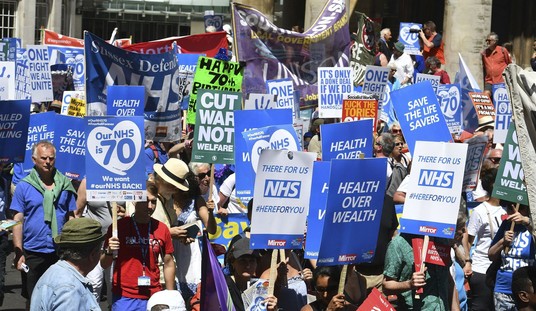Looks like another federal court doesn’t support the idea that Homeland Security’s writ includes America’s “cognitive infrastructure.” In a unanimous ruling yesterday, the Fifth Circuit expanded bars on the Biden administration’s Big Brother censorship activities, blocking the Cybersecurity and Infrastructure Security Agency (CISA) from any speech-policing communication with private-sector media platforms.
This comes from a further review of Missouri v Biden, which the Supreme Court will also take up in an ill-advised appeal by the administration to an earlier ruling:
The CISA, described as the “nerve center” of federal government censorship, is responsible for censoring the American public, facilitating collusion between the feds and social media companies, and interfering in our elections. Now, CISA, along with the Surgeon General, White House, Federal Bureau of Investigation (FBI), and Centers for Disease Control and Prevention (CDC), cannot communicate with social media companies for the purpose of policing speech, according to Federalist Contributor and Editor at Large of Real Clear Investigations Benjamin Weingarten. The court’s original opinion, which addressed the White House, FBI, CDC, and Surgeon General, did not include CISA.
The court stated that CISA “shall take no actions, formal or informal, directly or indirectly, to coerce or significantly encourage social-media companies to remove, delete, suppress, or reduce, including through altering their algorithms, posted social-media content containing protected free speech,” according to an excerpt providedby Weingarten.
In the original injunction, district court Judge Terry Doughty issued a broad preliminary injunction against all government agencies. (The trial phase has yet to take place, don’t forget.) For some reason, the Fifth Circuit narrowed it considerably on appeal, to the point where there appeared to be daylight for the Big Brother/Big Tech censorship complex to continue operating. Rather than take the sotto voce W, however, the Biden administration appealed that order to the Supreme Court — which doesn’t appear terribly sympathetic to government agencies claiming new jurisdictions on their own, especially at the cost of constitutional rights.
Now, however, the Fifth Circuit seems inclined to correct itself, and not in the way that the White House hoped. The unanimous ruling reinforces Doughty’s original findings that nearly every government agency cited by plaintiffs in Missouri v Biden engaged in unconstitutional viewpoint suppression (except for NIAID), and that pressure by officials at all of these agencies transformed the private social-media platforms into agents of government censorship:
The Plaintiffs allege that federal officials ran afoul of the First Amendment by coercing and significantly encouraging “social-media platforms to censor disfavored [speech],” including by “threats of adverse government action” like antitrust enforcement and legal reforms. We agree.
The government cannot abridge free speech. U.S. Const. amend. I. A private party, on the other hand, bears no such burden—it is “not ordinarily constrained by the First Amendment.” Manhattan Cmty. Access Corp. v. Halleck, 139 S. Ct. 1921, 1930 (2019). That changes, though, when a private party is coerced or significantly encouraged by the government to such a degree that its “choice”—which if made by the government would be unconstitutional, Norwood v. Harrison, 413 U.S. 455, 465 (1973)—“must in law be deemed to be that of the State.” Blum v. Yaretsky, 457 U.S. 991, 1004 (1982); Barnes v. Lehman, 861 F.2d 1383, 1385– 36 (5th Cir. 1988).9 This is known as the close nexus test.10
The decision then walks through the actions of the various agencies/respondents in the complaint, and explains how each of them acted coercively, using intimidation and in some cases directing their censorship actions directly. This includes the White House itself through the Surgeon General, the FBI, the CDC, and then crucially CISA, which arrogated unto itself the jurisdiction of “cognitive infrastructure” — ie, our minds. The Fifth Circuit panel doesn’t address jurisdiction directly, but makes clear that they pursued their vision through blatantly unconstitutional means, including on election-related speech and debate:
First, CISA was the “primary facilitator” of the FBI’s interactions with the social-media platforms and worked in close coordination with the FBI to push the platforms to change their moderation policies to cover “hack-and-leak” content. Second, CISA’s “switchboarding” operations, which, in theory, involved CISA merely relaying flagged social-media posts from state and local election officials to the platforms, was, in reality, “[s]omething more.” Roberts, 742 F.2d at 228. CISA used its frequent interactions with socialmedia platforms to push them to adopt more restrictive policies on censoring election-related speech. And CISA officials affirmatively told the platforms whether the content they had “switchboarded” was true or false. Thus, when the platforms acted to censor CISA-switchboarded content, they did not do so independently. Rather, the platforms’ censorship decisions were made under policies that CISA has pressured them into adopting and based on CISA’s determination of the veracity of the flagged information. Thus, CISA likely significantly encouraged the platforms’ content-moderation decisions and thereby violated the First Amendment.
Even then, the panel still wants to narrow Doughty’s original injunction, but sounds less than enthusiastic in doing so. In the end, they defend Doughty’s intended scope, and while they don’t restore the injunction to some of the officials named initially, the court makes clear their intent to close down any daylight perceived in their previous ruling:
We do not uphold the injunction against all the officials named in the complaint. Indeed, many of those officials were permissibly exercising government speech, “carrying out [their] responsibilities,” or merely “engaging in [a] legitimate [] action.” Vullo, 49 F.4th at 718–19. That distinction is important because the state-action doctrine is vitally important to our Nation’s operation—by distinguishing between the state and the People, it promotes “a robust sphere of individual liberty.” Halleck, 139 S. Ct. at 1928. That is why the Supreme Court has been reluctant to expand the scope of the doctrine. See Matal v. Tan, 582 U.S. 218, 235 (2017) (“[W]e must exercise great caution before extending our government-speech precedents.”). If just any relationship with the government “sufficed to transform a private entity into a state actor, a large swath of private entities in America would suddenly be turned into state actors and be subject to a variety of constitutional constraints on their activities.” Halleck, 139 S. Ct. at 1932. So, we do not take our decision today lightly.
But, the Supreme Court has rarely been faced with a coordinated campaign of this magnitude orchestrated by federal officials that jeopardized a fundamental aspect of American life. Therefore, the district court was correct in its assessment—“unrelenting pressure” from certain government officials likely “had the intended result of suppressing millions of protected free speech postings by American citizens.” We see no error or abuse of discretion in that finding.
And this time, the court makes clear the “daylight” involved:
It is true that the officials have an interest in engaging with socialmedia companies, including on issues such as misinformation and election interference. But the government is not permitted to advance these interests to the extent that it engages in viewpoint suppression. Because “[i]njunctions protecting First Amendment freedoms are always in the public interest,” the equities weigh in Plaintiffs’ favor.
In other words, the government is free to enter the public square and offer its opinions on truth and error. But they cannot pressure these platforms into censoring speech, let alone directly order the silencing of Americans involved in political debate.
The ruling goes on to confirm their earlier ruling vacating all but section 6 of the original injunction while adding CISA to the agencies enjoined. This appears to be the Fifth Circuit’s attempt to remedy the CISA question, but also to clarify its earlier ruling when the Supreme Court takes up discussion of the government’s appeal. Jonathan Turley sees it as a “major victory for free speech” on its own merits:
Jen Easterly, who heads the Cybersecurity and Infrastructure Security Agency, extended her agency’s mandate over critical infrastructure to include “our cognitive infrastructure.” The resulting censorship efforts included combating “malinformation” – described as information “based on fact, but used out of context to mislead, harm, or manipulate.”
Easterly is now barred from taking any action to T“coerce or significantly encourage” tech companies to remove or reduce the spread of posts. The Supreme Court may now have an opportunity to weigh in after the Justice Department appealed the injunction.
Bet on a SCOTUS ruling here. In the meantime, we can celebrate yet another exposure of the Big Brother nexus between government and Big Tech.








Join the conversation as a VIP Member